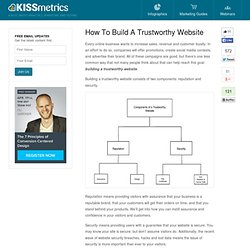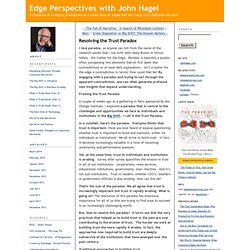

How To Build A Trustworthy Website. Every online business wants to increase sales, revenue and customer loyalty.

In an effort to do so, companies will offer promotions, create social media contests, and advertise their brand. All of these campaigns are good, but there’s one less common way that not many people think about that can help reach this goal: building a trustworthy website. Building a trustworthy website consists of two components: reputation and security. Reputation means providing visitors with assurance that your business is a reputable brand, that your customers will get their orders on time, and that you stand behind your products. We’ll get into how you can instill assurance and confidence in your visitors and customers. Security means providing users with a guarantee that your website is secure. We’ll go through some techniques that you can implement to ensure visitor security. Let’s first look at the elements of reputation. Reputation Different people are affected by different things. Customers Served Awards.
How to Build Website Trust and Authority. Trust Me: Here's Why Brands Sell Trust, Subconsciously. Let's say that not that long ago you came across a fascinating article.

But when you later try to verify some of the facts, you just can't pinpoint exactly where you first read it. What you do recall is that the source was reliable and you trusted the message. This is a situation I find myself in quite regularly. So much so, that I've pondered the conundrum and come up with a theory: we store information according to how trustworthy we deem the source of the message to be. There's more to it. Many studies demonstrate that trust, above all else, becomes a more salient feature in our life as we grow older. In a 2010 study conducted by Harvard professor Bharat Anand, and Alezander Rosinski, they examined how the power of ads are influenced by the magazine or newspaper they appear in.
Which brings me back to my theory on how we store information according to our levels of trust. But there was one observation that totally surprised me. The answer was a clear and resounding "Yes! " Resolving the Trust Paradox. I love paradox, as anyone can tell from the name of the research center that I run with John Seely Brown in Silicon Valley – the Center for the Edge.

Paradox is basically a puzzle, often juxtaposing two elements that at first seem like contradictions or at least defy explanation. Isn’t a center for the edge a contradiction in terms? How could that be? By engaging with a paradox and trying to sort through the apparent contradiction, one can often generate profound new insights that expand understanding.
Framing the Trust Paradox A couple of weeks ago at a gathering in Paris sponsored by the Orange Institute, I explored a paradox that is central to the challenges and opportunities we face as individuals and institutions in the Big Shift. In a nutshell, here’s the paradox. Yet, at the same time, trust in individuals and institutions is eroding. That’s the nub of the paradox: We all agree that trust is increasingly important but trust is rapidly eroding. But, how to resolve this paradox? Use This Content Process to Help You Build Trust.